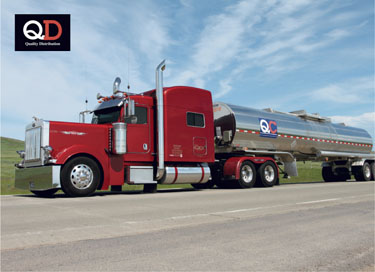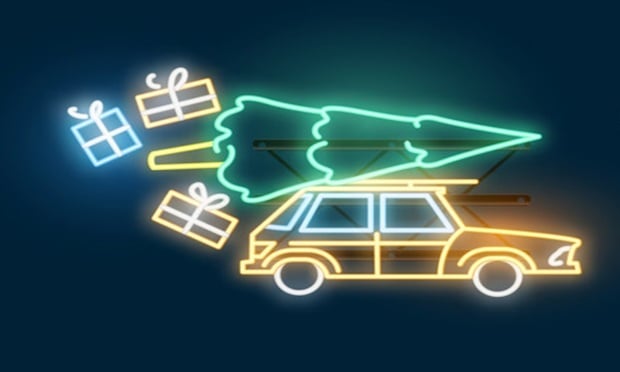 Potentially explosive cargo, stressful week-long drives and unpredictable weather conditions are just a few of the many risks trucking-company Quality Distribution Inc. (QD) has to overcome in transporting bulk items for clients such as DuPont, Bayer, Sunoco, ExxonMobil, Procter & Gamble and Unilever.
Potentially explosive cargo, stressful week-long drives and unpredictable weather conditions are just a few of the many risks trucking-company Quality Distribution Inc. (QD) has to overcome in transporting bulk items for clients such as DuPont, Bayer, Sunoco, ExxonMobil, Procter & Gamble and Unilever.
Since many of the goods carried by QD's trucks—among them plastics, dry and liquid food-grade items, and oil—will eventually be processed into other items, the contents of its trucks are typically in highly concentrated forms that can be poisonous or flammable if spilled.
“Transporting hazardous materials presents a real set of challenges,” says Mike McDonald, vice president of enterprise risk management at Tampa-based QD. “We transport chemicals from a database numbering 15,000 substances, many of them lethal.”
McDonald, who has been with QD for nearly a decade, knows well the daunting list of exposures faced by trucking firms: He has been in transportation risk management for 35 years, with experience that includes working in a risk-management capacity at Ryder System, another national trucking company.
The trucking industry is, in essence, one long supply chain—and it is essential to the U.S. economy.
“Most of the products transported in this country move on trucks,” notes McDonald. “It's too expensive to put goods on an airplane, and railroads can only go where the tracks are. But trucks can go everywhere.”
Leading the loss-control efforts that come with such a massive undertaking—and staying compliant with an array of federal transportation laws governing everything from worker safety to the safeguarding of chemicals—obviously requires some serious risk-management capabilities.
Here's how McDonald copes with one of the toughest assignments in risk management.
SAFETY TRAINING AGAINST MYRIAD HAZARDS
According to the Pipeline and Hazardous Materials Safety Administration (PHMSA), a division of the Department of Transportation (DOT), more than 8,000 incidents involving the accidental exposure of hazardous materials while they were being transported have occurred thus far in 2012, causing upward of $45 million in damages. Driver error was a leading cause of these losses.
 PHMSA spokesman Gordon “Joe” Delcambre Jr. points out that cargo-tank rollovers account for 31 percent of large-truck rollover crashes. “In 75 percent of those crashes, unsafe driver behaviors such as inattention or excessive speeding are the primary causes,” he says.
PHMSA spokesman Gordon “Joe” Delcambre Jr. points out that cargo-tank rollovers account for 31 percent of large-truck rollover crashes. “In 75 percent of those crashes, unsafe driver behaviors such as inattention or excessive speeding are the primary causes,” he says.
Given those statistics, one of the most important strategies QD pursues to control the company's liability is hiring and training the best drivers—who can avoid the many perils on the nation's highways.
To ensure that all the drivers QD uses are prepared for the responsibility of maintaining the safety of their cargoes—and the public with whom they share the road—the company requires an annual DOT-mandated physical, drug-screening, and a background check of moving violations.
If they pass these checks, drivers progress to one of several regional four-day training programs hosted in Salisbury, N.C.; Joliet, Ill.; and Houston.
There, students learn about hazmat handling and transloading (moving loads from railroad cars to trucking containers); the proper use of safety equipment; and how to pull tankers filled with liquid. If they complete that program (and if, McDonald emphasizes, they still want to drive for safety-focused QD), the company pairs the new hire with a trainer for up to two weeks.
McDonald himself went to the Houston school for a day to examine its teachers and curricula.
“Afterward, I took all my claims adjusters down to the Tampa terminal to work on one of our trucks so they could find out just how difficult of a job this is,” he says.
Everyone on this site visit soon learned that “not only do our drivers manage the wheel, but they load and unload the products by themselves. We're that kind of company: aggressive, hands-on and in control of our costs.”
ACCIDENTS DO HAPPEN: THE SPILL DRILL
However, not all accidents are preventable through driver vigilance—and if an incident does occur, QD can call one of its two specialty North American environmental-emergency response vendors: American Compliance Technologies and Emergency Response & Training Solutions, both of which maintain a network of cleanup contractors that can respond to a scene at any time of day or night.
The emergency contractors provide spill-tracking and management in compliance with OSHA, EPA and DOT regulations. Cleanup specialists can identify the hazardous or nonhazardous material that was spilled; remove, transport and dispose of the leaked product; and treat the contained spill site.
 Additionally, QD maintains two call centers—one dedicated to claims and another to ERM issues—staffed by a total of 17 employees and seven full-time risk professionals who address both its insured and enterprise risks.
Additionally, QD maintains two call centers—one dedicated to claims and another to ERM issues—staffed by a total of 17 employees and seven full-time risk professionals who address both its insured and enterprise risks.
In situations such as equipment impairment, accidents or spills, the claims center gets the call.
The Extended Services center deals with incidents that don't directly cause claims but that can create business interruption. It would, for instance, take a call from a driver whose debit card is not working at a gas station and wire him or her money.
UNDERWRITING LARGE FLEETS NO SMALL CHALLENGE
The size of Quality Distribution's fleet—3,300 tractors (or “power units”) and 7,500 trailers—makes insurers take a long, hard look before underwriting QD's risks, says McDonald.
Like many other companies dealing with potentially perilous materials, QD has had to find an additional self-insuring solution to make sure all its bases are covered.
“Insurance companies look at you differently if you own thousands of trucks versus hundreds,” says McDonald. “Insurers view large trucking companies as a much greater risk than a small company in terms of power units. If my company has 200 trucks, I can get 50 quotes from insurance companies.” Come in with a fleet the size of QD's, however, and that list of potential insurers shrinks considerably.
The company's Trucking and Auto Liability, General Liability, and Workers' Compensation are underwritten by Zurich.
 Because QD is “very confident in our ability to control the magnitude of claims,” McDonald says, the company is willing to take a $2 million-per-claim deductible for its Auto Liability exposures.
Because QD is “very confident in our ability to control the magnitude of claims,” McDonald says, the company is willing to take a $2 million-per-claim deductible for its Auto Liability exposures.
The trucking company self-insures against physical damage to its fleet and other equipment. And in the trucking business, costs for a total loss of equipment can be substantial. For example, a new trailer-pulling tractor can cost up to $125,000, and a specialty hazmat trailer falls within the price range of $55,000 to $150,000.
Damage to this expensive trucking equipment doesn't always happen on the road, either.
“Equipment damage is often caused by putting the wrong cargo in the wrong tank,” says McDonald. “I'll bet you didn't know that concentrated mayonnaise can eat through stainless steel pretty quickly.”
To help avoid such potentially disastrous snafus, full-time chemists are employed by QD's environmental and tech-services departments.
“Whenever we need to transport a new substance, the product has to go by the chemist to be paired with the right type of tank to avoid pitting and internal damage,” McDonald adds
Want to continue reading?
Become a Free PropertyCasualty360 Digital Reader
Your access to unlimited PropertyCasualty360 content isn’t changing.
Once you are an ALM digital member, you’ll receive:
- Breaking insurance news and analysis, on-site and via our newsletters and custom alerts
- Weekly Insurance Speak podcast featuring exclusive interviews with industry leaders
- Educational webcasts, white papers, and ebooks from industry thought leaders
- Critical converage of the employee benefits and financial advisory markets on our other ALM sites, BenefitsPRO and ThinkAdvisor
Already have an account? Sign In Now
© 2024 ALM Global, LLC, All Rights Reserved. Request academic re-use from www.copyright.com. All other uses, submit a request to [email protected]. For more information visit Asset & Logo Licensing.








